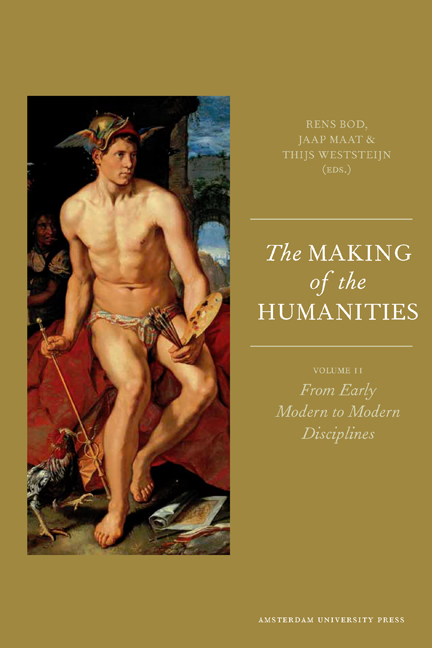Book contents
- Frontmatter
- Contents
- Introduction: The Dawn of the Modern Humanities
- I Linguistics and Philology
- II The Humanities and the Sciences
- III Writing History and Intellectual History
- IV The Impact of the East
- V Artworks and Texts
- VI Literature and Rhetoric
- VII Academic Communities
- Contributors
- List of Figures
- Index
The Mutual Making of Sciences and Humanities: Willebrord Snellius, Jacob Golius, and the Early Modern Entanglement of Mathematics and Philology
Published online by Cambridge University Press: 19 January 2021
- Frontmatter
- Contents
- Introduction: The Dawn of the Modern Humanities
- I Linguistics and Philology
- II The Humanities and the Sciences
- III Writing History and Intellectual History
- IV The Impact of the East
- V Artworks and Texts
- VI Literature and Rhetoric
- VII Academic Communities
- Contributors
- List of Figures
- Index
Summary
The making of the humanities was the making of the sciences at the same time. It is chiefly a story of reciprocal demarcation that gave, in the course of the nineteenth century, the sciences and the humanities distinct profiles. In early modern learning the distinction between the products of the human mind and of nature did not exist. The process of disentanglement may have started in the early modern period but it was driven by ‘scientific’ and ‘humanistic’ developments alike. In this article I will reflect upon the early modern relationship between the sciences and the humanities from the perspective of the mathematical sciences. The starting point consists of two instances of philological work in mathematics in early seventeenth-century Leiden. The background is not entirely coincidental. By 1600 the University of Leiden had become a bulwark of humanism and this affected the academic pursuit of mathematics as well. In the work of Willebrord Snellius (Snel van Royen, 1580-1626) and Jacob Golius (Gool, 1596-1667) philology was at the core of mathematics. I will take a closer look at the various purposes their philological work served and then address the more general historical question how such pursuits came to be separated from mathematics ‘proper’.
Ancient measures
In the summer of 1615 three men of mathematics were travelling through the Dutch province of Holland. The expedition was led by Willebrord Snellius, professor of mathematics at the University of Leiden. In 1613 he had succeeded his father Rudolph Snellius (1546-1613), the university's first professor of mathematics, after having received a broad academic training at his alma mater and abroad. Snellius was assisted by two young noblemen, Erasmus and Casparus Sterrenberg, and they got help from several notables along the way. The goal of the expedition was a precise determination of the distance between Alkmaar and Bergen op Zoom, two towns that were more or less at the same longitude. With the distance and the difference in latitude of both places, the length of the meridian and thus the circumference of the Earth could be calculated.
- Type
- Chapter
- Information
- The Making of the HumanitiesVolume II: From Early Modern to Modern Disciplines, pp. 73 - 92Publisher: Amsterdam University PressPrint publication year: 2012



